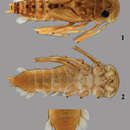Description
provided by Zookeys
Body size: up to at least 14.5 mm (not full grown nymph).
Coloration pattern: see Figs 1–2.
Head. Labrum moderately expended laterally, less than 4 times larger than long, with rounded apexes (as in Fig. 16); dorsal surface and anterior margin covered with long and thin setae; ventral surface with a median arch of less than 10 strong and pointed setae. Crown of the galea-lacinia of the maxillae composed of ca. 25 comb-shape setae, the median ones bearing 12–15 teeth. Right mandible with 5–6 bifid and fimbriate setae below the inner incisor and ca. 10 long simple and thin setae below the mola; left mandible with 8–9 simple and fimbriate setae below the inner incisor and ca. 9–10 long simple and thin setae below the mola. Hypopharynx with robust lingua bearing a tuft of small setae, superlinguae densely covered with long and thin setae replaced before the apex by very small setae up to the lower part of the superlinguae (Fig. 27). Labium with glossae rhomboid, slightly concave on their outer margin near apex (Fig. 20), dorsal surface with three stout setae and numerous thin and simple setae.
Voucher # CO1 16S 28S H3 wg EF-1α 340 SuTh HE651394 HE651430 HE651453 HE651512 HE651485 HE651535 346JaTh HF536601 HF536587 HF536594
Thorax. Pronotum weakly expended laterally (Fig. 1). Femora with submarginal rows of pointed bristles on the inner and outer margins, increasing in numbers from the fore to the hind leg. Bristles on the upper face of hind femora arrow-shaped, clearly pointed (Fig. 29). Hind tibia (Fig. 30) without any bristles in outer marginal or submarginal position. Tarsal claw with 2–3 teeth.
Abdomen. Posterolateral expansions not developed on segments I–II, increasing in size from segment III to VII where it may reach the middle of segment VIII, shorter on segment VIII (Fig. 3) and comparable proportionally to those of segments V–VI. Gill I (Fig. 38) with elongated and rounded plate, ca 2.5× longer than wide; gill IV strongly asymmetrical (Fig. 39), wider than long, gill VI and VII oval and asymmetrical with obtuse apex (Figs 40–41). Posterior margin of tergites with irregular pointed teeth, and numerous microdenticles (Fig. 35). Cerci rather unicolor medium brown, some segments darker in the proximal half.
- bibliographic citation
- Sartori M (2014) The species of Thalerosphyrus Eaton, 1881 (Insecta, Ephemeroptera, Heptageniidae, Ecdyonurinae) in Java and Sumatra, with some comments on the diversity of the genus in the Oriental Realm ZooKeys 420: 19–39
- author
- Michel Sartori
Distribution
provided by Zookeys
2 nymphs, Java, Diengplateau, stream Seraju (D13), ca 1950 m a.s.l., 5.VI.1929, Prof. Thienemann leg. [ZMH]; 1 nymph entirely mounted on microscopic slide, Java, Gedeh Panggerango, Tjisarua, 1050 m, 10.VIII.1930, Dr. Lieftinck leg [ZMH]; 1nymph, Java, Java Barat Province, rocky stream at Cibodas (CL 2186), 1300 m, 3.XI.1985, J.T. & D.A. Polhemus leg [MZL]; 1 nymph, Bali, Baturiti, Desa Antapan, 815 m, 8°19.34'S, 115°11.61'E, 9.X.2009 (BLI005), M. Balke & D. Amran leg [MZL]; 1 nymph, Sumbawa, Nusa Tenggara Barat Province, Madsewu River, 2 km above Badindi, 61 km NW of Bima (CL 2174), 750 m, 20.X.1985, J.T. & D.A. Polhemus leg [MZL].
Eggs extracted from a female imago (caught together with a male imago) and identified by Ulmer as Thalerosphyrus determinatus: West Java, Tjibodas, Tjiwalen Bridge, 1400 m, 4.IX.1932, Dr Lieftinck leg [ZMH].
- bibliographic citation
- Sartori M (2014) The species of Thalerosphyrus Eaton, 1881 (Insecta, Ephemeroptera, Heptageniidae, Ecdyonurinae) in Java and Sumatra, with some comments on the diversity of the genus in the Oriental Realm ZooKeys 420: 19–39
- author
- Michel Sartori

